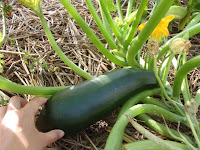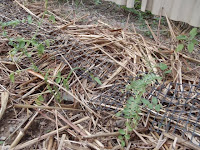 Sad to say, but although the tomato plants are yielding fruit, they have been afflicted by wilt. I would suspect it is the infamous 'bacterial wilt' which tropical soils are known for. Fusarium and Verticilium wilt are deadly because they attack the roots of the plant and stop it from receiving nutrients from the soil. The plant displays early symptoms of wilt through its drooping leaves and branches. In the intermediary stages, the branches and leaves of the affected plant look severely brown and dry, no matter how much water you give the plant. The final stage, brown discolouration may take place on the plant stems and at the base of the plant. The affected plant withers a slow, lingering death. Fruit may remain unaffected, as the plant pours all its remaining energy into it. However, fruit produced may be drier and more tart than normal.
Sad to say, but although the tomato plants are yielding fruit, they have been afflicted by wilt. I would suspect it is the infamous 'bacterial wilt' which tropical soils are known for. Fusarium and Verticilium wilt are deadly because they attack the roots of the plant and stop it from receiving nutrients from the soil. The plant displays early symptoms of wilt through its drooping leaves and branches. In the intermediary stages, the branches and leaves of the affected plant look severely brown and dry, no matter how much water you give the plant. The final stage, brown discolouration may take place on the plant stems and at the base of the plant. The affected plant withers a slow, lingering death. Fruit may remain unaffected, as the plant pours all its remaining energy into it. However, fruit produced may be drier and more tart than normal. The only way to avoid wilt is to plant in pots, using sterilised potting mix and not letting plants make contact with any soil from the garden. I thought I had isolated two Grosse Lisse tomato plants using this technique. However this was before the wilt began rearing its ugly head in the garden beds affecting the cherry tomatoes. Unbeknownst to me, I had dealt the fatal blow to the Grosse Lisse by layering the bottom of the container with regular garden soil. The wilt slowly crept upwards and although the fruit was still large and healthy, the Grosse Lisse fell victim to this grim reaper of tomatoes....
The only way to avoid wilt is to plant in pots, using sterilised potting mix and not letting plants make contact with any soil from the garden. I thought I had isolated two Grosse Lisse tomato plants using this technique. However this was before the wilt began rearing its ugly head in the garden beds affecting the cherry tomatoes. Unbeknownst to me, I had dealt the fatal blow to the Grosse Lisse by layering the bottom of the container with regular garden soil. The wilt slowly crept upwards and although the fruit was still large and healthy, the Grosse Lisse fell victim to this grim reaper of tomatoes....
 The worst thing is that the wilt has spread to the eggplants. I thought eggplants were immune to wilt, as some gardeners recommend grafting tomato plants onto eggplants in order to avoid wilt. However, I found out that this applies to only certain types of eggplants, such as the Thai variety (small and green).
The worst thing is that the wilt has spread to the eggplants. I thought eggplants were immune to wilt, as some gardeners recommend grafting tomato plants onto eggplants in order to avoid wilt. However, I found out that this applies to only certain types of eggplants, such as the Thai variety (small and green).
Perhaps the wilt has also affected the sweetcorn plants, which took on a cardboard brown colour a few weeks back. All the corn ears being produced were dry and 'unfinished'. Or maybe it is the mealybugs that the ants have farmed, which have sapped the corn dry. I don't know. But between the wilt and the ants, I DO know that corn and tomatoes did not make it through this season. Question is, has this put me off planting tomatoes ever again?

DRIED UP CORN EAR
 Sad to say, but although the tomato plants are yielding fruit, they have been afflicted by wilt. I would suspect it is the infamous 'bacterial wilt' which tropical soils are known for.
Sad to say, but although the tomato plants are yielding fruit, they have been afflicted by wilt. I would suspect it is the infamous 'bacterial wilt' which tropical soils are known for. 














